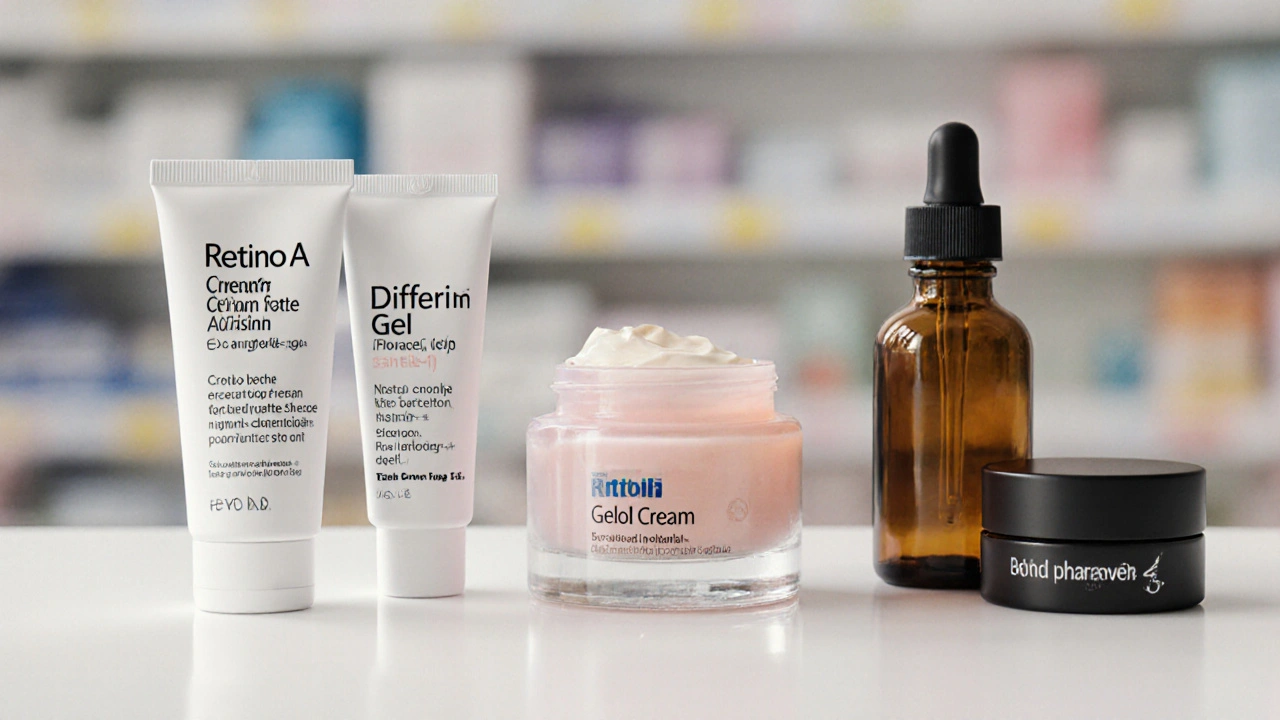
Retino A Cream 0.025% vs. Alternatives Comparison Tool
Product Comparison Overview
Retino A Cream 0.025%
Active Ingredient: Tretinoin
Concentration: 0.025%
Prescription: Yes
Cost: £22-30/month
Irritation: High (4/5)
Best for: Fast acne clearance and strong anti-aging results
Generic Tretinoin
Active Ingredient: Tretinoin
Concentration: 0.025%
Prescription: Yes
Cost: £10-18/month
Irritation: High (4/5)
Best for: Same effectiveness at lower cost
Differin Gel (Adapalene)
Active Ingredient: Adapalene
Concentration: 0.1%
Prescription: No
Cost: £12-15/month
Irritation: Low (2/5)
Best for: Beginners and sensitive skin
Retinol Cream
Active Ingredient: Retinol
Concentration: 0.3-2%
Prescription: No
Cost: £20-45/month
Irritation: Very Low (1-2/5)
Best for: Gradual texture improvement
Tazarotene Cream
Active Ingredient: Tazarotene
Concentration: 0.1%
Prescription: Yes
Cost: £45-70/month
Irritation: Medium (3/5)
Best for: Strong acne treatment with less irritation
Key Takeaways
- Retino A Cream 0.025% is a prescription‑only tretinoin that delivers the strongest proven results for acne and photo‑aging, but it also carries the highest irritation risk.
- Generic tretinoin creams match the active ingredient and concentration at a fraction of the price, though brand‑specific excipients can affect tolerability.
- Adapalene (Differin) and retinol offer milder, over‑the‑counter options that work well for beginners or sensitive skin.
- Tazarotene provides a middle ground: prescription strength with a slightly lower irritation profile than tretinoin, but it’s usually pricier.
- Choosing the right product depends on skin type, treatment goals, budget, and whether you have a dermatologist’s guidance.
This Retino A Cream comparison breaks down how it stacks up against other treatments you’ll find on UK pharmacy shelves in 2025.
What is Retino A Cream 0.025%?
When it comes to tackling stubborn acne or fine lines, Retino A Cream 0.025% is a prescription‑only tretinoin formulation approved in the UK for treating acne vulgaris and photo‑aged skin. The active ingredient, tretinoin, belongs to the retinoic acid family and works by speeding up cell turnover, unclogging pores, and stimulating collagen production. Because it’s a pure form of retinoic acid, the results are often quicker and more dramatic than with over‑the‑counter retinol, but the trade‑off is a higher chance of redness, peeling, and sun sensitivity.
How Does Tretinoin Work?
At the cellular level, tretinoin binds to retinoic acid receptors (RARs) in the nucleus of skin cells. This binding triggers a cascade that:
- Increases the rate at which keratinocytes (skin cells) mature and shed.
- Reduces the stickiness of cells lining hair follicles, preventing comedone formation.
- Stimulates fibroblasts to produce new collagen, smoothing fine lines.
- Boosts the production of glycosaminoglycans, improving skin hydration.
These mechanisms explain why tretinoin remains the gold standard for both acne and anti‑aging, but they also underline why the initial weeks can feel like a skin‑burn.
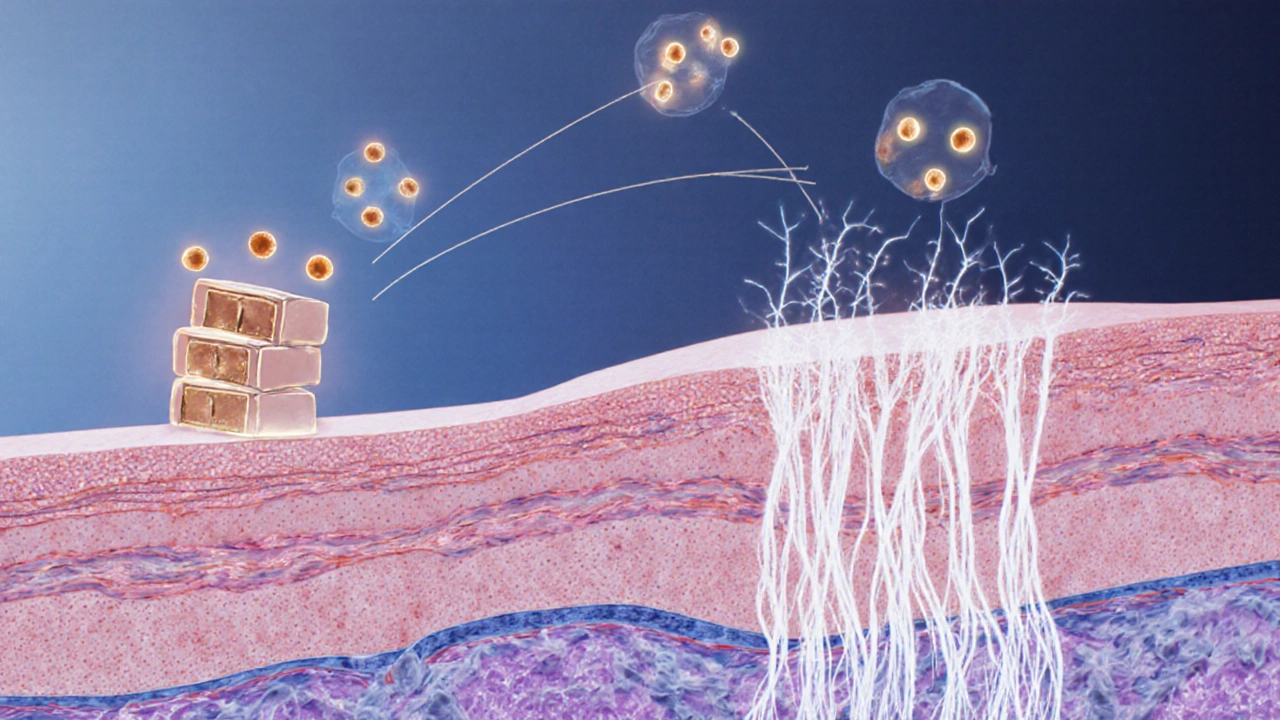
Common Alternatives to Retino A
Not everyone can or wants to get a prescription for tretinoin. Below are the most widely used alternatives, each with its own set of strengths and drawbacks.
Generic Tretinoin Cream 0.025%
Many UK pharmacies stock a non‑brand version of tretinoin at the same 0.025% strength. The active ingredient and concentration are identical, so the clinical effect is comparable. Differences lie in the cream base-some use lighter emulsifiers that feel less greasy, while others may contain more alcohol, which can increase irritation. Prices typically range from £10 to £18 for a 30‑gram tube, substantially cheaper than the branded Retino A.
Differin Gel (Adapalene 0.1%)
Differin Gel is an over‑the‑counter retinoid containing 0.1% adapalene, approved for acne treatment. Adapalene is chemically related to tretinoin but binds more selectively to RAR‑β, resulting in a gentler irritation profile. It’s a favorite for beginners, teenagers, and people with sensitive skin. While it improves acne and offers modest anti‑aging benefits, it won’t match the collagen‑boosting power of tretinoin.
Retinol Cream (OTC)
Retinol is the oxidised precursor of retinoic acid. Your skin must convert it step‑by‑step before it becomes active, which means results appear more slowly but the side‑effects are milder. Common concentrations range from 0.3% to 2%, and most products are sold as moisturising creams or serums. They’re ideal for those who want gradual texture improvement without the typical “retinoid flush”. However, they usually cost £20‑£45 for a 30‑ml bottle, and you’ll need several weeks before seeing visible changes.
Tazarotene Cream 0.1%
Tazarotene Cream is a prescription‑only third‑generation retinoid used for plaque psoriasis and severe acne. It works similarly to tretinoin but has a higher affinity for RAR‑γ, which can reduce irritation for some users. The trade‑off is price: a 30‑gram tube typically costs £45‑£70. Tazarotene also carries a black‑box warning for pregnancy, making it unsuitable for anyone who could become pregnant.
Side‑by‑Side Comparison
| Product | Active Ingredient | Concentration | Prescription Required? | Typical Monthly Cost (GBP) | Main Use | Irritation Rating* (1‑5) |
|---|---|---|---|---|---|---|
| Retino A Cream | Tretinoin | 0.025% | Yes | £22‑£30 | Acne & anti‑aging | 4 |
| Generic Tretinoin | Tretinoin | 0.025% | Yes | £10‑£18 | Acne & anti‑aging | 4 |
| Differin Gel | Adapalene | 0.1% | No | £12‑£15 | Acne (mild‑moderate) | 2 |
| Retinol Cream | Retinol | 0.3‑2% | No | £20‑£45 | Anti‑aging, texture | 1‑2 |
| Tazarotene Cream | Tazarotene | 0.1% | Yes | £45‑£70 | Severe acne, psoriasis | 3 |
*Irritation rating is based on typical patient reports: 1=very mild, 5=severe.
Decision‑Making Checklist
- Prescription status: If you cannot see a dermatologist quickly, an OTC option like Differin or retinol may be more realistic.
- Skin sensitivity: Sensitive or rosacea‑prone skin usually benefits from lower‑irritation choices (adapalene or low‑dose retinol).
- Goal urgency: For fast acne clearance, tretinoin or tazarotene are best; for gradual anti‑aging, retinol suffices.
- Budget: Generic tretinoin gives the same potency for half the price of the brand.
- Pregnancy plans: Avoid tretinoin, adapalene, and tazarotene if you could become pregnant; stick to pregnancy‑safe alternatives like certain niacinamide‑based moisturisers.
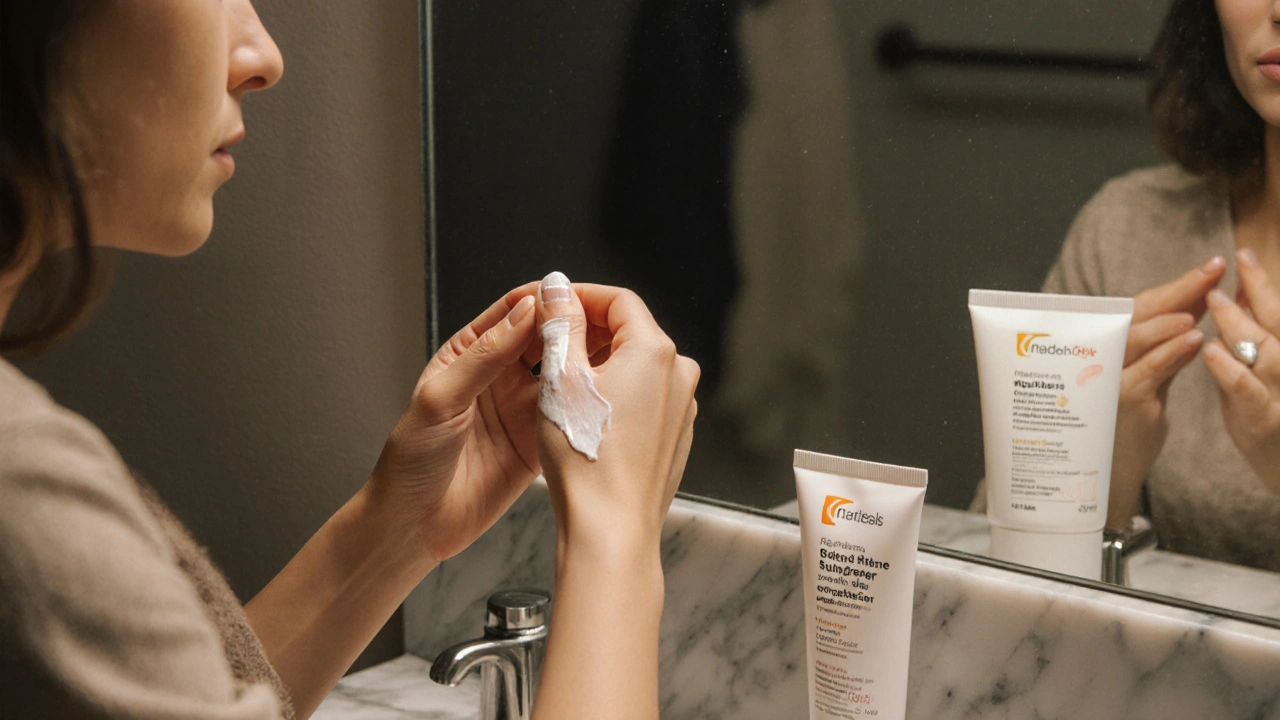
How to Use Retino A and Its Alternatives Safely
Regardless of the product, a few universal rules cut down on irritation and boost results:
- Start slow. Apply a pea‑sized amount every third night for the first two weeks.
- Use a gentle, sulfate‑free cleanser and postpone exfoliation while your skin adjusts.
- Follow up with a fragrance‑free moisturizer within 5‑10 minutes to lock in hydration.
- Never skip sunscreen. A broad‑spectrum SPF30+ sunscreen is a daily non‑negotiable.
- If redness exceeds a mild pink tone, cut back to every other night or switch to a lower concentration.
For prescription products, your Dermatologist a qualified skin‑care specialist who can tailor retinoid therapy to your individual needs may recommend adjunctive treatments like benzoyl peroxide or azelaic acid to minimise resistance.
Pricing & Availability in the UK (2025)
Retail chains such as Boots, Superdrug, and LloydsPharmacy carry both brand and generic tretinoin, but you’ll need a prescription from your GP or dermatologist. Online pharmacies that require a valid prescription typically charge a dispensing fee of £2‑£5 on top of the product cost. OTC alternatives-Differin, retinol serums, and some low‑dose tretinoin creams marketed as “cosmetic”-are shelf‑stable and can be bought without a doctor’s note.
Insurance (NHS) generally does not cover cosmetic retinoids, but it does reimburse prescription tretinoin for severe acne when a dermatologist’s letter is submitted. Private health plans may offer partial reimbursement for tazarotene, but check the policy details.
Bottom Line: Which One Is Right for You?
If you have moderate‑to‑severe acne, a clear‑cut prescription for Retino A or its generic counterpart will likely give the fastest results, provided you can tolerate the irritation. If you’re new to retinoids, a gentle over‑the‑counter option like Differin or a low‑dose retinol cream lets you build tolerance without a prescription. For patients needing a middle ground-strong enough for acne but less harsh than tretinoin-tazarotene can be a solid compromise, albeit at a higher price.
Ultimately, the smartest approach combines the right product with proper skin‑care habits and professional guidance. Don’t hesitate to book a short consultation with a dermatologist; a few minutes of advice can save weeks of trialanderror.
Frequently Asked Questions
Can I use Retino A while pregnant?
No. Tretinoin is classified as CategoryC and has been linked to birth defects in animal studies. Pregnant or planning to become pregnant individuals should avoid all prescription retinoids and opt for pregnancy‑safe alternatives.
How long does it take to see results with Retino A?
Most patients notice a reduction in breakouts after 4‑6 weeks, with noticeable texture improvement and fine‑line smoothing appearing around the 12‑week mark.
Is generic tretinoin as effective as Retino A?
Clinically, yes-both contain 0.025% tretinoin. Differences arise from the cream base, which can affect absorption and tolerability. Many users find generic versions just as effective once they adjust the formulation to their skin type.
Can I combine Differin with Retino A?
Mixing two retinoids isn’t recommended because it dramatically increases irritation risk. If you want to switch, taper off one product for 1‑2 weeks before starting the other.
What sunscreen should I use with retinoids?
Choose a broad‑spectrum SPF30+ formula with zinc oxide or titanium dioxide for physical protection. Look for “non‑comedogenic” labels to avoid clogging pores.


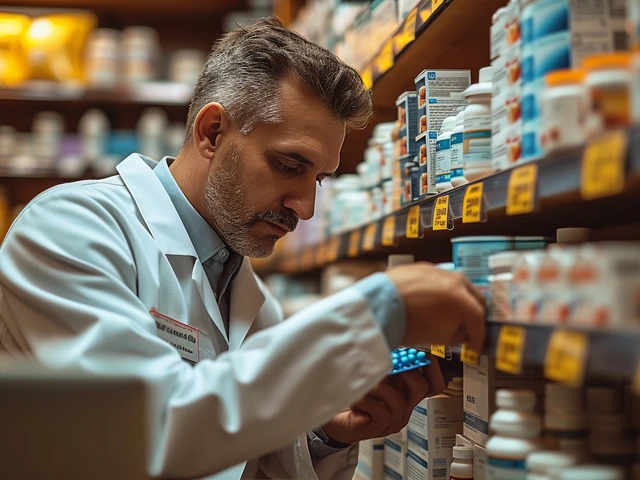
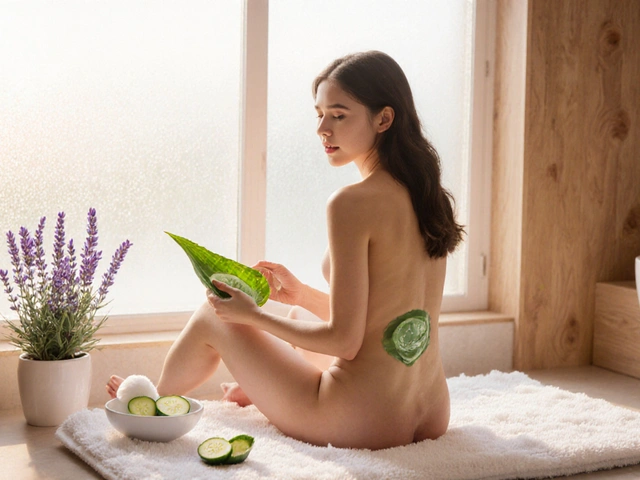
Mansi Mehra
October 10, 2025 AT 19:00Retino A Cream 0.025 % is a prescription‑only formulation that provides potent acne and anti‑aging benefits; however, its high irritation potential necessitates careful usage under dermatological supervision. The active ingredient, tretinoin, accelerates keratinocyte turnover and stimulates collagen synthesis, which explains its efficacy. Patients should commence with a pea‑sized amount applied every third night, combine with a fragrance‑free moisturizer, and always use broad‑spectrum SPF 30 or higher. Regular follow‑up appointments allow dose adjustments to mitigate erythema and peeling. In contrast, generic tretinoin offers identical concentration at a lower cost but may contain different excipients influencing tolerability.
Danielle Spence
October 10, 2025 AT 19:50It is simply irresponsible to purchase potent retinoids over the counter without medical guidance; the skin barrier is not a playground for experiments. When people skip professional advice, they invite needless suffering-redness, peeling, and even long‑term hyperpigmentation. You owe it to your skin to respect the expertise of dermatologists, who can tailor treatment to your specific condition and monitor side‑effects. Ignoring this duty is a form of self‑neglect that reflects poorly on our collective health ethic. The market may tempt you with cheaper generics, but the moral cost of potential damage outweighs any financial saving.
Dhanu Sharma
October 10, 2025 AT 20:40i tried the diffren gel before switching to retino a it was way easier on my skin i didnt get that crazy peeling i still saw some breakouts but they cleared slower than with the prescription version but i liked the low irritation level overall it felt more manageable for everyday use
Edward Webb
October 10, 2025 AT 21:30What you describe touches on the broader dialectic between efficacy and tolerability; the higher potency of tretinoin inevitably invites a stronger inflammatory response, yet this very response indicates cellular renewal. One might view the initial discomfort as a necessary rite of passage toward clearer skin, balancing the immediate sacrifice against the long‑term aesthetic reward. Nonetheless, individual thresholds vary, and honoring one’s own comfort is as philosophically valid as chasing maximal results.
Snehal Suhane
October 10, 2025 AT 22:20Oh, look, another worshipper of “the brand” who thinks a logo magically reduces irritation. News flash: the active molecule is identical, it’s just the filler that changes, not some mystical unicorn dust. If you’re willing to pay extra for the same pharmacology, congratulations on funding the pharmaceutical vanity machine.
Ernie Rogers
October 10, 2025 AT 23:10actually it's not just about the brand its about supporting local pharma and keeping the supply chain safe you know those cheap generics sometimes come from places with lax regs*
Eunice Suess
October 11, 2025 AT 00:00i cant believe how many peple think retino a is some kind of magic potion it’s not, it’s a powerful acid that can fry your face if you dont treat it right! use a light moisturizer after and dont forget sunscreen or you will regret it later.
Anoop Choradia
October 11, 2025 AT 00:50While the emotional outburst is understandable, one must also consider the covert motivations behind the proliferation of high‑potency retinoids. Certain pharmaceutical conglomerates deliberately obscure formulation differences to manufacture dependence, ensuring a perpetual market for their products. A discerning consumer ought to scrutinize not only the active concentration but also the subsidiary excipients, whose origins may be linked to undisclosed supply chains of questionable provenance.
bhavani pitta
October 11, 2025 AT 01:40Despite prevailing consensus, I maintain that over‑the‑counter retinoids outperform many prescription options in real‑world tolerability.
Brenda Taylor
October 11, 2025 AT 02:30yeah sure 🙄 if you love constant peeling and burning then go ahead its your skin not ours
virginia sancho
October 11, 2025 AT 03:20Hey folks, just a quick tip – start with a low‑dose retinol product and slowly build up to stronger retinoids. This gradual approach helps your skin adapt and reduces the risk of severe irritation. Also, always follow up with a good moisturizer and sunscreen. Feel free to ask if you need product recommendations!
Namit Kumar
October 11, 2025 AT 04:10Indeed, incremental escalation is scientifically supported 😊 maintaining barrier integrity while introducing retinoids minimizes adverse events and optimizes long‑term outcomes.
Sam Rail
October 11, 2025 AT 05:00Honestly, I’ve been through the whole retinoid maze and I can say that the differences between these products are less about magic and more about practicalities. First, cost matters – paying £30 a month for a brand name when a generic does the same job feels like a rip‑off. Second, prescription access can be a hurdle; not everyone has the time or insurance to see a dermatologist every few months. Third, irritation is the real deal‑breaker – if your skin turns into a tomato after a week, you’ll probably quit anyway. Fourth, I’ve found that layering a gentle ceramide cream beneath any retinoid reduces the “burn” feeling dramatically. Fifth, sunscreen isn’t optional; forget it and you’ll undo all the anti‑aging benefits in a single sunburn. Sixth, when I switched from Differin to Retino A, my acne cleared faster but the initial redness was intense. Seventh, a gradual introduction – start with two nights a week, then add a third after two weeks – helps the skin acclimate. Eighth, many users report that using a niacinamide serum in the morning complements retinoids by calming inflammation. Ninth, don’t be fooled by “cosmetic tretinoin” products; they often contain lower percentages and won’t give you the same results. Tenth, if you’re pregnant or may become pregnant, steer clear of tretinoin, adapalene, and tazarotene – the risks simply aren’t worth it. Eleventh, keep a simple journal of how your skin reacts; noting redness, peeling, and breakouts helps you and your dermatologist fine‑tune the regimen. Twelfth, remember that “results” take time – be patient for at least three months before judging effectiveness. Thirteenth, for those on a tighter budget, buying a larger generic bottle can save pounds in the long run. Fourteenth, always check the expiration date; retinoids lose potency after a year. Fifteenth, the key takeaway is to balance potency, cost, and skin tolerance to find the sweet spot that works for you.
Taryn Thompson
October 11, 2025 AT 05:50To synthesise the points raised, a structured approach begins with a baseline tolerance assessment, proceeds to incremental dosing, and incorporates barrier‑supportive moisturisers and daily broad‑spectrum photoprotection. Should any adverse reactions exceed mild erythema, de‑escalation or a switch to a lower‑irritancy agent such as adapalene is advisable. This balanced protocol maximises therapeutic benefit while minimising discomfort.